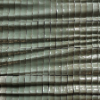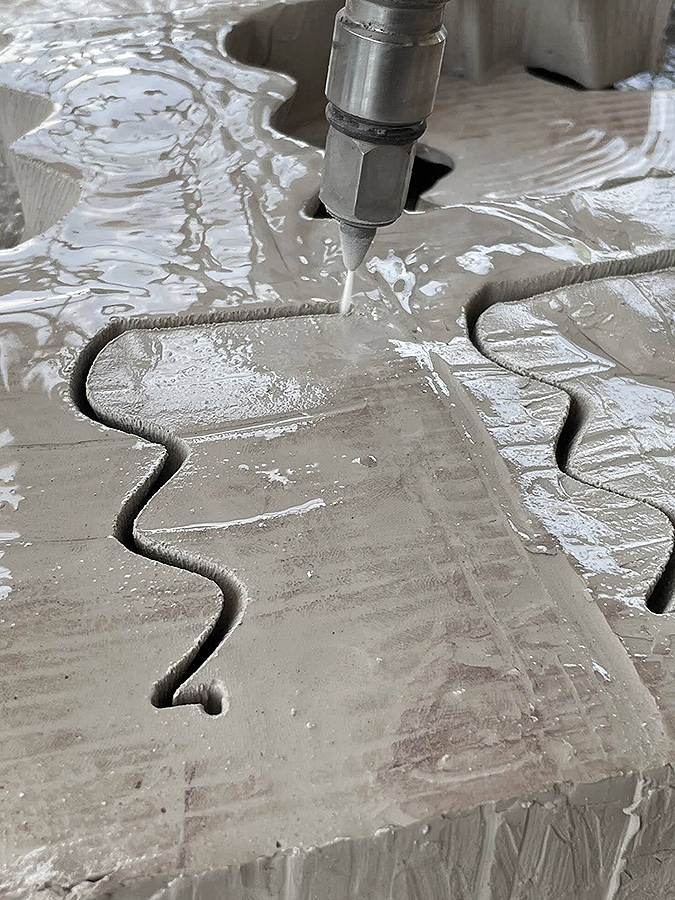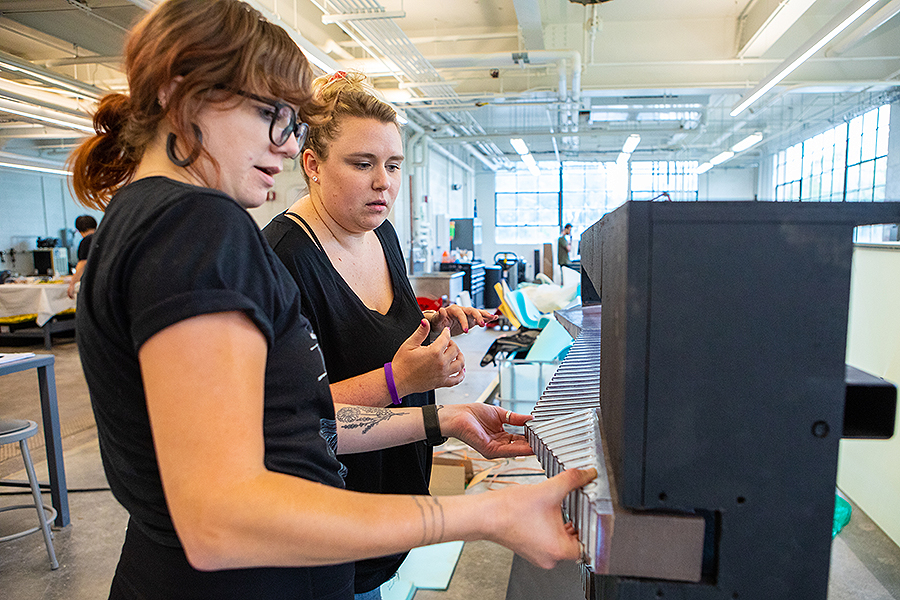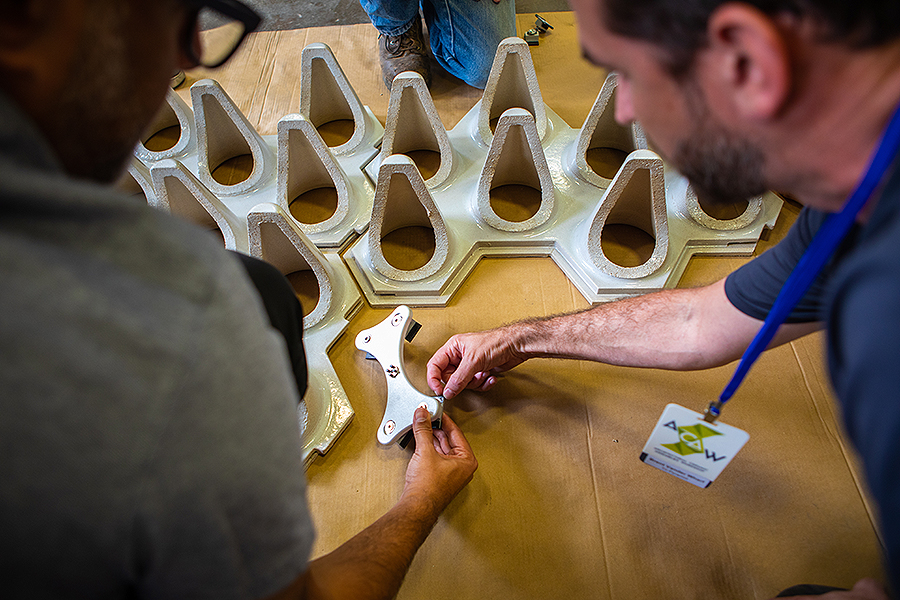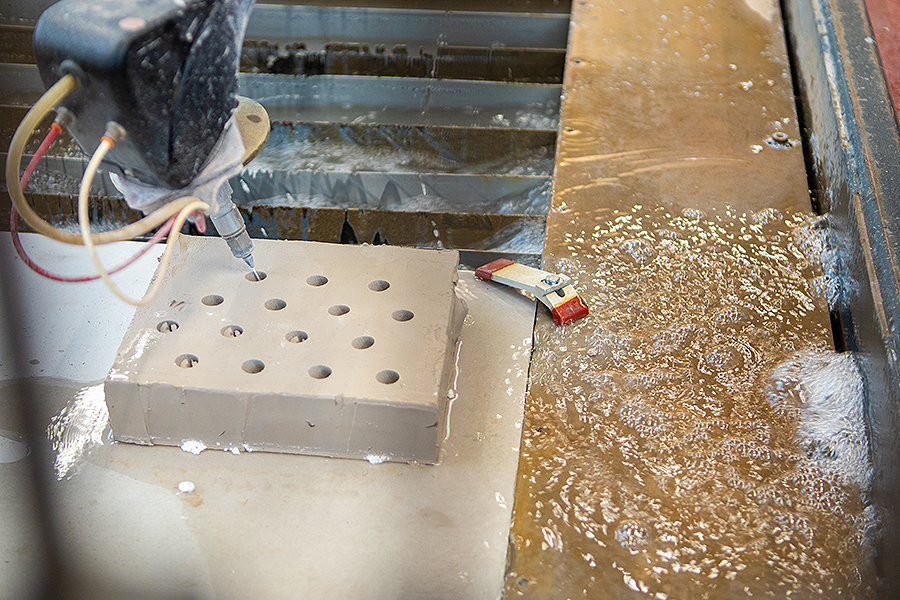campus news
With ACAW as backdrop, UB students push boundaries of terra cotta
Attendees at the Architectural Ceramic Assemblies Workshop work inside the SMART Fabrication Factory in Parker Hall. Photo: Douglas Levere
By DAVID J. HILL
Published October 21, 2022
Inside the SMART Fabrication Factory in Parker Hall on the South Campus sits a very powerful tool, one that is revolutionizing what’s possible within the world of architectural clay.
Students in the School of Architecture and Planning got to experiment with it, learn how to use it and create prototypes with it as part of an intensive, six-week summer studio that culminated in a presentation during the Architectural Ceramic Assemblies Workshop (ACAW), a yearly event co-hosted at UB with Boston Valley Terra Cotta and Carnegie Mellon University.
The tool is an industry-scale, five-axis, waterjet cutter, and it’s a device that can cut almost any material by using a high-pressure stream of water without any heat; the studio explored the possibility of utilizing the machine to cut wet ceramic materials.
“Before this studio I was thinking, oh, cutting things with high-speed water, that’s future tech that’s never going to be applicable to our field,” second-year graduate student Dustin Klinger said in mid-August during a break in the action in the SMART Fabrication Factory, a prototyping facility that supports research with industry and faculty research in material fabrication and digital craft.
“And here we are learning how to interface with it for four weeks, learning that this technology is a lot more accessible than we thought.
“The idea behind our prototype wasn’t so much to make a cool pattern and put it on these panels. It was saying that digitally you could create almost any pattern and put it on any panel,” adds Klinger. “This way, you’re not destroying molds and creating waste when you’re going through them. You can create any number of molds and patterns.”
The studio was led by Dan Vrana, clinical assistant professor in the Department of Architecture and director of the SMART (Sustainable Manufacturing and Advanced Robotic Technologies) Fabrication Factory, which brings together architecture, engineering, management and economics to advance research in next-generation technologies.
Tinkering with technology
Vrana, who is also a graduate of the school, designed the course as a technical exploration (as opposed to design focused) studio exploring the potential to achieve complex, customized terra cotta designs that can work at an industry scale with existing digital manufacturing tools, aligning with ACAW’s annual goal of expanding the boundaries of terra cotta applications in the industry.
“We reconsidered the terra cotta fabrication process by using casts of wet clay, which cut at a significantly faster rate than traditional methods using (kiln) fired casts, with none of the risk to the material or the machine,” says Vrana. For example, one job Vrana ran on the waterjet cutter took 90 seconds using a wet clay cast. It took 13 minutes using fired clay.
For the first week of the class, students visited several facilities — including Boston Valley Terra Cotta, Rigidized Metals, Buffalo Wire Works, Southside Precast Products and the New York State College of Ceramics at Alfred University — to gain an understanding of current manufacturing processes and identify opportunities to improve efficiency and workflow.
The students pushed the limits of terra cotta design by leveraging the waterjet’s back-end software, a program that was developed by Edmund Harriss from the University of Arkansas with assistance from Vrana, Nicholas Bruscia (UB Department of Architecture) and Mark Rogers of waterjet manufacturer OMAX.
“The software essentially creates an interface between a 3D-modeling program we use every day and a complicated digital manufacturing machine, allowing us to prescribe and visualize five-axis cutting paths in a familiar environment,” says Vrana. “As a result of the powerful software, we were able to position the machine as a tool that could be utilized along with the students’ existing skillsets.”
Two different prototypes
Students were split into two teams, each tasked with creating a different prototype. Sub-teams then experimented with terra cotta glazes to develop new mixtures that achieved unique color gradients.
The groups were broadly split into two categories: perforation and extrusion. Ideas surrounding perforated facades led to experimentation in hand-pressed, contoured panels that could be precisely digitally modeled and then three-dimensionally tracked to cut a gradient of beveled holes, a process that would be difficult, if not impossible, to execute precisely with traditional techniques.
Taking a critical look at existing extrusion shapes and methods, the second group explored how simple, easily extruded clay blanks could be cut and aggregated to reveal the appearance of a continuous surface, taking advantage of the precision of the waterjet in cutting subtle, five-axis paths that morph from top to bottom and left to right in the final assembly.
Both groups presented their prototypes to industry representatives and world-renowned architecture firms that participated in the seventh annual Architectural Ceramic Assemblies Workshop.
Building on partnership with Boston Valley Terra Cotta
The studio expanded on more than a decade of work between the School of Architecture and Planning and Boston Valley Terra Cotta, an academia-industry partnership that helped create the workshop, which brings industry representatives, practicing architects and academics from around the world to Buffalo for a week to push the boundaries of architectural terra cotta.
Through ACAW, students have the opportunity to work alongside teams of professionals in the field, and several UB students have received job opportunities as a result of the connection generated by the workshop.
Caterina Gnecco networked with Boston Valley Terra Cotta during ACAW 2022, which brought up the possibility of doing an internship this winter. Gnecco was a graduate assistant for the summer studio, and she served a critical role in much of the technical work, including running the waterjet cutter.
“I thought it was a terrifying machine at first,” she says. “But now that I’ve gotten more comfortable with it, it’s just cool to see how much it can do. This is a completely new experience for me, working with clay. It’s been an interesting jump, but I’m very happy I’ve been involved.”
For first-year graduate student Rachel Kramp, the only regret was that the course was only a month and a half. “I wish it was a 15-week course,” she said. “It was a lot compressed into a short time,” Kramp adds. “But I’m so proud of the finished product, and that we created it in less than a month.”
Kramp worked on the glazing for her team’s prototype. After roughly 70 tests, they developed a two-tone dipping process to create a greenish glaze with a slight white tint that accentuates where the light hits the terra cotta panels on their prototype.
The studio opened up Kramp’s eyes to the possibilities of working with architectural clay.
“I never expected to be experimenting with clay in architecture,” she said. “It gave me a better understanding of the material and how it can be used architecturally. It also gave me a lot more respect for the craftsmen who work with this very difficult material because it’s a beast. There’s a certain level of unexpectedness that you just have to expect with it.”



